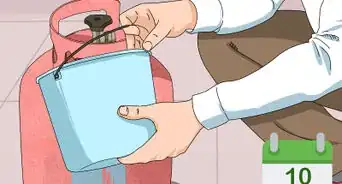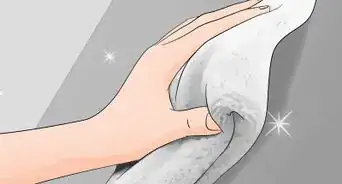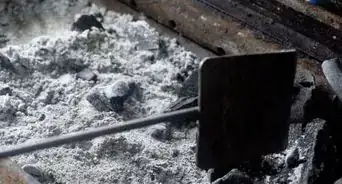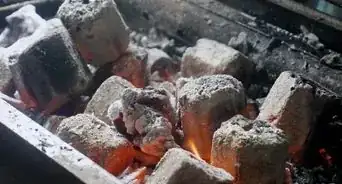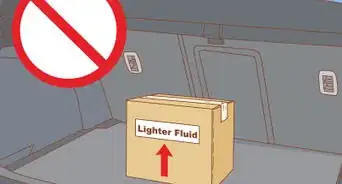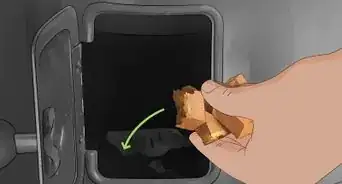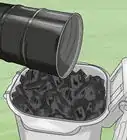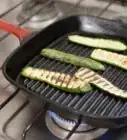This article was co-authored by Filip Boksa. Filip Boksa is the CEO and Founder of King of Maids, a U.S. based home cleaning service that helps clients with cleaning and organization.
There are 7 references cited in this article, which can be found at the bottom of the page.
This article has been viewed 29,615 times.
Over time, your charcoal grill will build up ash and rust over time. Clean your grill at least once every grilling season, or twice if you use your grill frequently.[1] Doing so will help your grill last longer, the food made on it taste better, and the grilling process safer.[2] Maintain your grill by scraping away encrusted buildup and removing ash. Oil your grill to prevent food from sticking to it. Prevent fish from sticking by using a fish basket or preparing it on a griddle.
Steps
Maintaining Your Grill
-
1Locate a suitable area to clean your grill. This area should be away from your campsite or off to the side of your yard. You'll be brushing ash and encrusted char off the grill at this location, so it should be far from walking paths.
- Choosing a cleaning location far from walking paths will prevent ash and char from being tracked around your campsite or home.
-
2Brush dirtiness from the grate. Take the grate out of the grill. The grate may stain your hands with ash and char. Prevent this from transferring to your skin with gloves. Brush the grate with a wire grill brush to remove buildup from the grate.[3]
- You can use Goo Gone Grill and Grate Cleaner if there is excessive dirt and grime on the grill grates.[4]
- Spray it directly on the grates and wipe with a damp cloth after a few minutes.[5]
- In most cases, you should be able to lift the grate out of the grill. Some grills may have slots the grate fits into or catches. Release the catches, if necessary, and slide the grill free.
- Use moderate force when brushing your grate and grill. Using excessive force may chip the coating on your grill, which could negatively impact its performance or void its warranty.[6]
EXPERT TIPFabricio Ferraz is the Co-Owner and Operator of Hire a Cleaning. Hire a Cleaning is a family owned and operated business that has been serving San Francisco, California homes for over 10 years.House Cleaning Professional
 Fabricio Ferraz
Fabricio Ferraz
House Cleaning ProfessionalTry this all-natural tip: Cut a lemon in half, then squeeze the lemon on top of the barbecue grill. When you're finished, use the cut surface of the lemon to scrub the grill grates, then wipe the grates clean with a rag. That way, there's no chemical residue, so you can use the grill again right away.
Advertisement -
3Remove buildup from the grill lid and bottom. Use your brush to clear out any encrusted bits on the bottom of the grill and its lid.[7] If you notice peeling paint, remove this with a stiff bristle brush or putty knife. Wipe the exterior of the lid and body of the grill with a rag wet with soapy water.
- If you’re using a public grill, you may want to place your hand in a plastic bag and sweep loose buildup into a separate plastic bag to be thrown away.[8]
-
4Throw away any leftover ashes from the ash catcher, if necessary. The ash catcher is a receptacle on the bottom of the grill where ashes collect over time. Some public grills may not be equipped with an ash catcher. Brush ashes into a plastic bag and throw these away.[9]
- Some ash catchers may detach from the grill for easy disposal. Slide the ash catcher out of grill, dump the ashes in a bag to be thrown away or directly into the garbage.
-
5Reassemble the grill. If you’ve removed the ash catcher, replace this before anything else. Then slide the grate into place. Press the grate with your hand to ensure it is sturdy and firmly in place. Your grill is now clean. You’re ready to grill.
- For the cleanest grilling, line the grate of your grill with aluminum foil. Poke some holes in the foil before lighting the grill.
- Using aluminum foil is highly recommended for public grills. You never know what’s been grilled previously.[10]
Oiling the Grate to Keep it Clean
-
1Heat up your grill. Clean your grill of all ash and buildup beforehand. Make sure the grate is free of residue. Light the grill according to its user instructions and allow it to heat up. When the grill is hot, you’re ready to apply oil to the grate.[11]
- Oiling the grate of your grill will prevent food from sticking to it, allowing you to flip and turn food more easily.
- Depending on your grill, it may take some time for the grill to heat up. Allow the grill to heat for a minimum of 10 to 15 minutes for the best results.
-
2Wet paper towel in oil. Use a cooking oil suitable for high heats. Some oils you might use include canola oil, olive oil, and peanut oil. Apply a moderate amount of oil to a wad of paper towel. There should be enough oil to coat the grate, but not so much that the oil drips from the paper towel.[12]
- Using too much oil can cause the paper towel to catch fire. For this reason, only lightly apply oil to your paper towel.[13]
- Oil can transfer easily to your skin and make a mess. Wear gloves to prevent this while wetting your paper towel with oil.
- Prepare your paper towel on a spare dish to prevent oil from getting on cooking or dining surfaces.
-
3Apply the oil to the grate with an oven mitt and tongs. Put an oven mitt on your dominant hand. With your mitted hand, pick up the tongs. Use the tongs to carefully wipe the grate with the paper towel. Cover all surfaces of the grate lightly with oil. Throw the paper towel out after using it.[14]
- When the grill is lit, there is a chance the paper towel may catch fire. If this happens, don’t panic. Remove the paper towel from the grill and dunk it in a bucket of water.
-
4Oil your grates when the grill is cold, alternately. In the same fashion described for oiling a hot grill, apply your oil to a cold grill grate with paper towel. Because the grill is cold, you can do so with your bare hands, though you may want to use gloves to prevent oil from getting on your skin.[15]
-
5Light your grill after applying oil to a cold grill. Light your grill according to its user instructions. As the grill heats, it will produce light smoke. This is normal. When the smoke stops, excess oil has been burned away and your grate is ready to grill food.[16]
Preventing Grilled Fish from Sticking to the Grate
-
1Grill fish at lower temperatures. This technique can be especially helpful with thick cuts of fish. Combined with a lower temperature, a light coating of refined olive oil or corn oil can also help prevent fish from sticking to the grate of your grill.[17]
-
2Use a fish basket. A fish basket is a grill accessory that hinges open to hold cuts of fish inside fine metal tines. Lightly oil the fish with a high temperature cooking oil and insert it into the basket. Use an oven mitt to pick up the handles of the basket and turn the fish when one side is finished cooking.
- The handles on many kinds of fish basket, while convenient for turning the basket, can sometimes prevent you from closing the lid of your grill. This may add to the cooking time of the fish.[18]
- If you don’t have a fish basket, wrap the fish in a packet of aluminum foil. Place this on your grill to cook the fish.[19]
-
3Prepare the fish on a suitable griddle. Place a cast iron griddle onto the grate of your grill. Lightly coat the griddle with a high temperature cooking oil. Place the fish on the griddle to cook it and flip the fish when its first side is finished cooking.
- A griddle with an oil-catching groove around the edges will prevent oil and fish juices from dripping into the flames. Oil and juices can cause flare ups.[20]
Warnings
- Even on the inside a grill, fires can sometimes get out of hand. Always keep a bucket of water on hand in case you need to douse the fire or dunk an oven mitt that’s aflame.⧼thumbs_response⧽
- Always follow the care and use instructions of your grill. Public grills are usually basic and sturdy in construction and will require less careful maintenance.⧼thumbs_response⧽
Things You’ll Need
Maintaining Your Grill
- Aluminum foil
- Stiff bristle brush (or putty knife; optional)
- Bucket of water (for dousing flames in an emergency)
- Fork
- Gloves (optional)
- Grill brush (or similar cleaning brush)
- Plastic bags (or paper ones)
- Rag
- Soap (like dish soap)
Oiling the Grate to Keep it Clean
- High-heat cooking oil (like canola, olive, or peanut oil; for oiling grate)
- Oven mitt
- Paper towel
- Tongs
Preventing Grilled Fish from Sticking to the Grate
- Aluminum foil
- Cast iron griddle
- Fish basket
- High-heat cooking oil (like canola, olive, or peanut oil; for oiling grate)
- Oven mitt
References
- ↑ http://www.thekitchn.com/how-to-clean-a-charcoal-grill-220949
- ↑ https://www.charbroil.com/community/how-to-clean-your-charcoal-grill/
- ↑ http://www.thekitchn.com/how-to-clean-a-charcoal-grill-220949
- ↑ Filip Boksa. House Cleaning Professional. Expert Interview. 20 August 2019.
- ↑ Filip Boksa. House Cleaning Professional. Expert Interview. 20 August 2019.
- ↑ https://www.charbroil.com/community/how-to-clean-your-charcoal-grill/
- ↑ Filip Boksa. House Cleaning Professional. Expert Interview. 20 August 2019.
- ↑ http://www.thekitchn.com/how-to-clean-a-charcoal-grill-220949
- ↑ https://www.charbroil.com/community/how-to-clean-your-charcoal-grill/
- ↑ http://www.thekitchn.com/how-to-clean-a-charcoal-grill-220949
- ↑ http://www.thekitchn.com/how-to-clean-a-charcoal-grill-220949
- ↑ https://www.charbroil.com/community/how-to-oil-a-grill-grate/
- ↑ http://www.seriouseats.com/2010/04/how-to-clean-your-grill-barbecue-oiling-thegrate-charcoal.html
- ↑ https://www.charbroil.com/community/how-to-oil-a-grill-grate/
- ↑ https://www.charbroil.com/community/how-to-oil-a-grill-grate/
- ↑ https://www.charbroil.com/community/how-to-oil-a-grill-grate/
- ↑ http://amazingribs.com/tips_and_technique/how_to_prevent_sticking.html
- ↑ http://amazingribs.com/tips_and_technique/how_to_prevent_sticking.html
- ↑ http://startcooking.com/grilling-fish-101
- ↑ http://amazingribs.com/tips_and_technique/how_to_prevent_sticking.html
About This Article
Before you clean a charcoal grill, put on a pair of rubber gloves to keep the ash and char from getting on your hands. Then, take the grate off the grill so you can remove the buildup from the bottom with a stiff bristle brush or putty knife. Once you’ve cleaned the inside, use a rag and soapy water to wipe the lid and the body of the grill. If your grill has an ash catcher, or a receptacle at the bottom where the ashes collect, make sure to empty the ashes into a plastic bag and throw them away. Finish by replacing the ash catcher and sliding the grate into place. To learn more, including how to keep your grate clean with cooking oil, scroll down!




